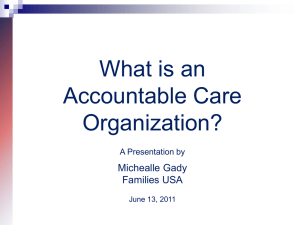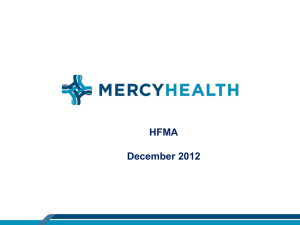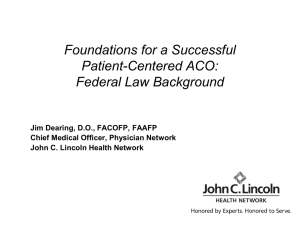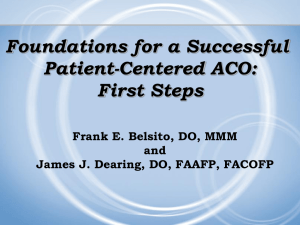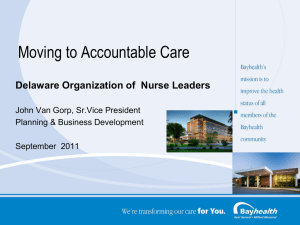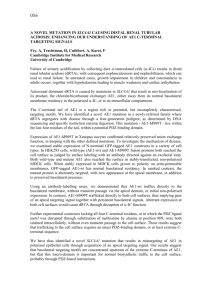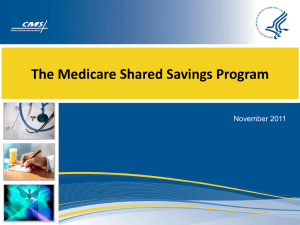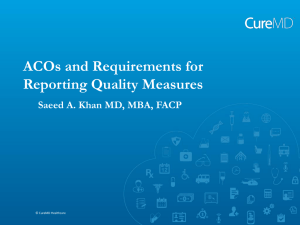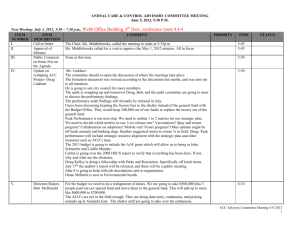Resource - Indiana Rural Health Association
advertisement
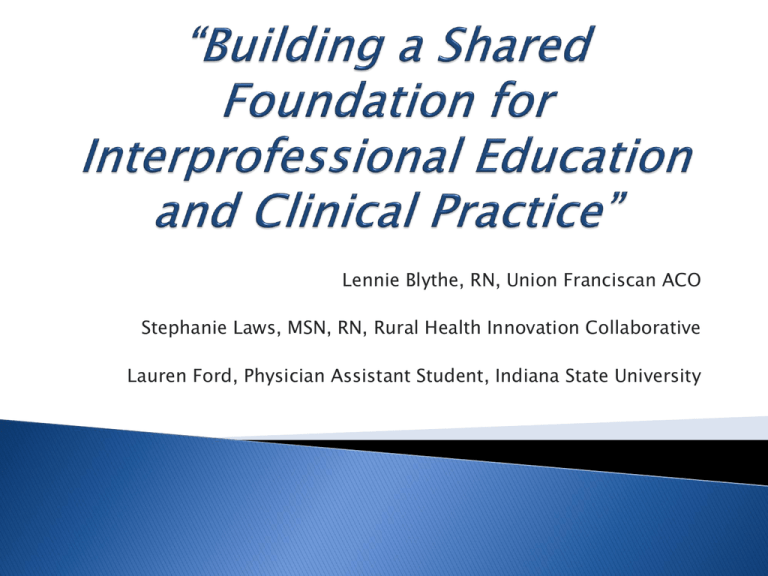
Lennie Blythe, RN, Union Franciscan ACO Stephanie Laws, MSN, RN, Rural Health Innovation Collaborative Lauren Ford, Physician Assistant Student, Indiana State University On March 23, 2010, the Patient Protection and Affordable Care Act (Healthcare Reform) was signed into law. Healthcare reform focused on two main areas: 1. Care delivery 2. Reimbursement • • “Value” focus: Payment increasingly tied to quality and cost. Centers for Medicare and Medicaid Services (CMS)- hospital payments now dependent on outcomes. Physician office payments affected starting 2015. Commercial- Increased payments to providers dependent on meeting quality standards. Summary: Healthcare reform focuses on ways to provide better care by giving providers more information and focusing in on quality/value….but how do we get there?? ACCOUNTABLE CARE ORGANIZATIONS (ACOs) An Accountable Care Organization is "an organization of health care providers that agrees to be accountable for the quality, cost, and overall care of Medicare beneficiaries who are enrolled in the traditional fee-for-service program who are assigned to it.“ ACOs are made up of groups of healthcare providers and provider entities that agree to work together to coordinate care for the patients they serve. Definition per the Center for Medicaid and Medicare Services (2012). 1. 2. 3. There are three main goals of an ACO, often referred to as the “Triple Aim” Better health for the population Higher-quality care Lower costs of care ACOs focus on providing better healthcare by improving quality and reducing costs across the entire continuum through: Improved care coordination Reduced waste (e.g. duplicate testing) Internal process improvement Informed patient choices & engaging patients and their families Chronic disease management Actionable, timely data (via health information technology and data sharing) Creation of partnerships across the continuum of care (preventative, acute, postacute) The ACO is focused on Medicare beneficiaries. Individuals with Medicare as a primary insurer can be “attributed” or assigned to the ACO. CMS attributes patients to the ACO. The ACO cannot choose which patients are in the ACO. Patients are attributed to the ACO based on providers. If the provider they see for the majority of the primary care based services joins the ACO, then there is a good chance that the will be attributed to the ACO. At this time only Medicare patients who have had traditional Medicare (both Part A &B coverage) for at least 12 months can be attributed. Medicare Advantage members cannot be in an ACO The west central Indiana demographic (Terre Haute MSA) ranked at or above the 75th percentile doe Normalized SNF Days per 1,000. Additionally, SNF readmissions within 30 days post-hospital discharge comprised a significant amount for conditions such as pneumonia, CHF, and post-orthopedic care. While the ACO has embraced many community partners the following skilled nursing facilities are the sites of our student-based project: Meadows Manor North Meadows Manor East Providence Health Care Springhill Village Center for Health Wellness and Life Enrichment Union Franciscan ACO The rotation is designed to provide students with autonomous, yet safe, learning opportunities that will enhance the students’ ability and confidence to perform medical assessments; formulate appropriate diagnoses or clinical suggestions based on findings; interpret laboratory and other diagnostic studies; complete comprehensive medical record reviews; and complete medication inventories for assigned patients. ACO GOALS: • • • • Better population health Higher quality care Lower costs of care Decreased readmissions through enhanced continuity. Decreased length of stay at each nursing home STUDENT GOALS: Enhanced knowledge of ACOs Enhanced clinical confidence and competence Interprofessional education/collaboration Workforce readiness Completing intake assessments for all assigned patients. Complete weekly rounds and required documentation on assigned patients. Communication with the assigned ACO Care Coordinator. 1st Year Physician Assistant Students Social Work Student (BSW candidate) ◦ 15 participated ◦ Completed 3 simulation experiences ◦ Completed surveys: Pre/Post ACO Knowledge Assessments Pre/Mid/Post Clinical Skills Confidence Meadows Manor East Meadows Manor North Providence Health Care Springhill Village 1st and 3rd Year Physician Assistant Students ◦ 58 students participating ◦ Split into 2 sessions To complete 2 simulation experiences To complete pre/post: ACO Knowledge Clinical Skills Confidence Weekly patient rounding ◦ Assigned to same 4 clinical sites Additional student disciplines being integrated: ◦ ◦ ◦ ◦ Behavioral Health Recreation Therapy Nursing Public Health Session 1 Chelsea Elwood Brianne Wagenman Mike Finigan Lindsey Graft Lauren Ford Erin Haaff Session 2 Rachel Sanderson Christopher Schmidt Marcus Schwab Sara Spring Cynthia Shepard Meredith Stackhouse Session 1 Amal Beydoun Joshua Chambers Justin David Colt Cansler Session 2 Joe Bonomoni Raymond (Ron) Contreras Jessica (Brooke) Dailey Emily McMahon Laura Mitchell Kate Pippins Emily Marshall Matt Nicholson Sara Niles Allison Pullar Jordan Pothast Session 1 Katherine Hill Justin Jacobsen LynnaireJastillano Cody Lawnichak Megan McGary Stephanie Tobin Session 2 Eleonor Sviridova Cherisa Fletcher Phil Swink Markay Wilson Joanne Vanderhyde Atiq Zamani Session 1 Jenifer Fortney Chase Hayes Carolyn Hanrahan Amber Thomas Eryn Hasenour Sarah Hogue Aaron Heaslet Shelby Howard Rachel Hewitt Krista Irwin Jennifer Simatovich Ryan Strom Jasmina Spahic Annemarie Spiezia Jay Swanson Brittany Heiser Brittany Stanek Session 2 Allison Lipps Michelle Ertl Elaine Gilbert Ruth Viehoff Stephanie Murphy Amanda Yeck Kelly Schuder Continued replication of project to additional skilled nursing facility sites (rural). Continued evaluation. (quality and cost) Opportunity for research and publication as it pertains to interprofessional student experiences. Policy change/management?
